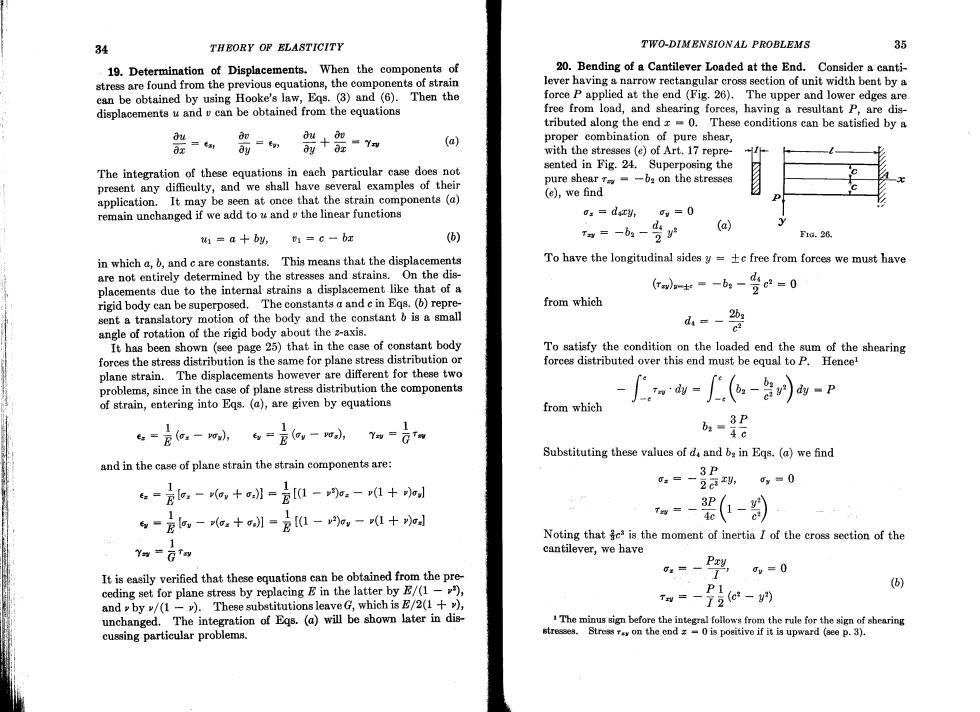
34 THEORY OF ELASTICITY TWO-DIMENSIONAL PROBLEMS 35 19.Determination of Displacements.When the components of 20.Bending of a Cantilever Loaded at the End.Consider a canti- stress are found from the previous equations,the components of strain lever having a narrow rectangular cross section of unit width bent by a can be obtained by using Hooke's law,Egs.(3)and (6).Then the force P applied at the end (Fig.26).The upper and lower edges are displacements u and v can be obtained from the equations free from load,and shearing forces,having a resultant P,are dis- tributed along the end x 0.These conditions can be satisfied by a ou a=6 =6别+ Yw (a) proper combination of pure shear, dy with the stresses (e)of Art.17 repre- The integration of these equations in each particular case does not sented in Fig.24.Superposing the present any difficulty,and we shall have several examples of their pure shear Ta--ba on the stresses application.It may be seen at once that the strain components (@ (e),we find remain unchanged if we add to 4 and v the linear functions 0:=dx4,y=0 (a) w1=a+bu,t1=c一bz (b) w=--台护 F1G.26 in which a,b,and c are constants.This means that the displacements To have the longitudinal sides y=tc free from forces we must have are not entirely determined by the stresses and strains. On the dis- placements due to the internal strains a displacement like that of a n=-b-受e=0 rigid body can be superposed.The constants a and c in Eqs.(b)repre- from which sent a translatory motion of the body and the constant b is a small angle of rotation of the rigid body about the z-axis. d=-20 c2 It has been shown (see page 25)that in the case of constant body To satisfy the condition on the loaded end the sum of the shearing forces the stress distribution is the same for plane stress distribution or forces distributed over this end must be equal to P.Heneel plane strain.The displacements however are different for these two problems,since in the case of plane stress distribution the components of strain,entering into Eqs.(a),are given by equations from which 1 1 1 &=Ea:-w小,s=io,-w小,Yw=石w -站 Substituting these values of d and b:in Eqs.(a)we find and in the case of plane strain the strain components are: 3P y=0 -言,-,+l-0-,-1+ 0=一22 与-豆,-o,+-安0-0,-0+咖l Ta=- (- Noting that fes is the moment of inertia I of the cross section of the 1 Ya-GTo cantilever,we have P型, It is easily verified that these equations can be obtained from the pre- 0y=0 ceding set for plane stress by replacing E in the latter by E/(1-), (6) and by v/(1-v).These substitutions leave G,which is E/2(1+), w=一72c2-9 unchanged.The integration of Eqs.(a)will be shown later in dis- 1The minus sign before the integral follows from the rule for the sign of shearing cussing particular problems. stresses.Stress ra on the cnd -0 is positive if it is upward (see p.3)
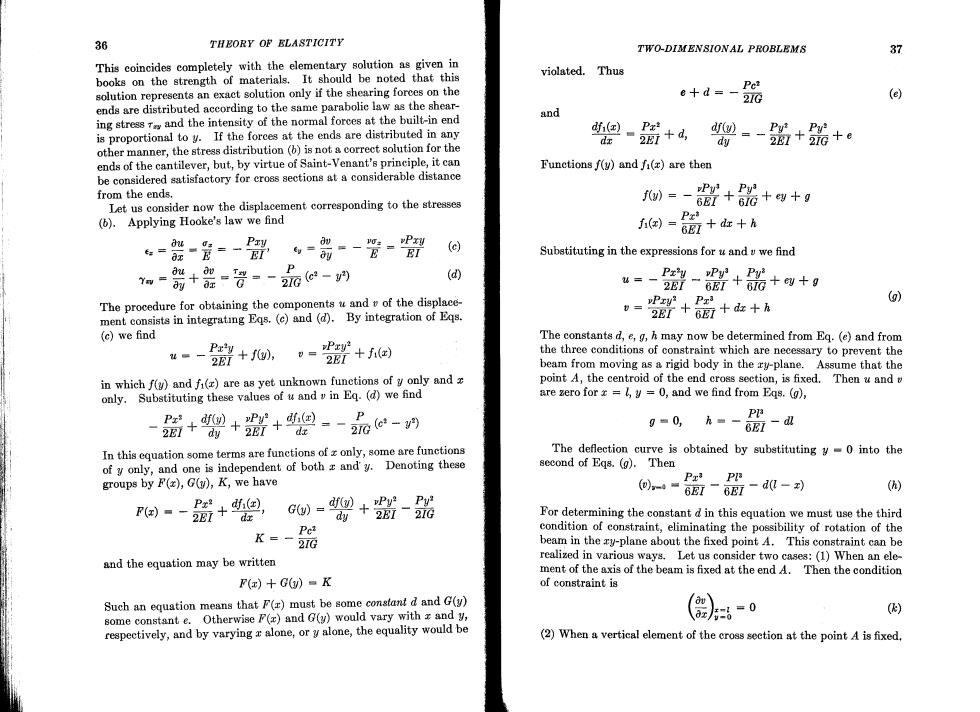
36 THEORY OF ELASTICITY TWO-DIMENSIONAL PROBLEMS 37 This coincides completely with the elementary solution as given in books on the strength of materials.It should be noted that this violated.Thus solution represents an exact solution only if the shearing forces on the e十d=- Pc2 21G (e) ends are distributed according to the same parabolie law as the shear- ing stress and the intensity of the normal forces at the built-in end and is proportional to y.If the forces at the ends are distributed in any (x)Px2 Py Py other manner,the stress distribution(b)is not a correct solution for the dx ■27+d, 地=-最+品+ dy ends of the cantilever,but,by virtue of Saint-Venant's principle,it can Functions f(y)and fi(x)are then be considered satisfactory for cross sections at a considerable distance from the ends. Let us consider now the displacement corresponding to the stresses 10=-置+篇+w+g (b).Applying Hooke's law we find 6E++h Pxs f()= EI (c) Substituting in the expressions for u and v we find 加-箭+器-音-品e-州 Ov P (d) Pxy vPy Py w=-2B-67+60+y+g The procedure for obtaining the components u and v of the displace- vPxy Px3 (g) 龙= ment consists in integrating Eqs.(c)and (d).By integration of Egs. 2量+67+k+h (c)we find The constants d,e,g,h may now be determined from Eq.(e)and from u= Px+@. 2ET 。=+ the three conditions of constraint which are necessary to prevent the beam from moving as a rigid body in the ry-plane.Assume that the in which f(y)and fi(r)are as yet unknown functions of y only and z point A,the centroid of the end cross section,is fixed.Then u and v only.Substituting these values of u and v in Eq.(d)we find are zero for =l,y =0,and we find from Eas.(g), +W+撒+2 Pxs 2G(e-9 PB g=0,h=-6- In this equation some terms are functions of z only,some are functions The deflection curve is obtained by substituting y=0 into the of y only,and one is independent of both z and'y.Denoting these second of Eqs.(g).Then groups by F(x),G(y),K,we have Px Pl 包=6立一6-d-刘 () Pro-瑞+9, dt 60-鳄+器-器 dy For determining the constant d in this equation we must use the third Pc condition of constraint,eliminating the possibility of rotation of the K=-2G beam in the ry-plane about the fixed point A.This constraint can be and the equation may be written realized in various ways.Let us consider two cases:(1)When an ele- ment of the axis of the beam is fixed at the end A.Then the condition F(x)+G()=K of constraint is Such an equation means that F(r)must be some constant d and G(y) some constant e.Otherwise F(z)and G(y)would vary with z and y, ()-0 () respectively,and by varying x alone,or y alone,the equality would be (2)When a vertical element of the cross section at the point A is fixed
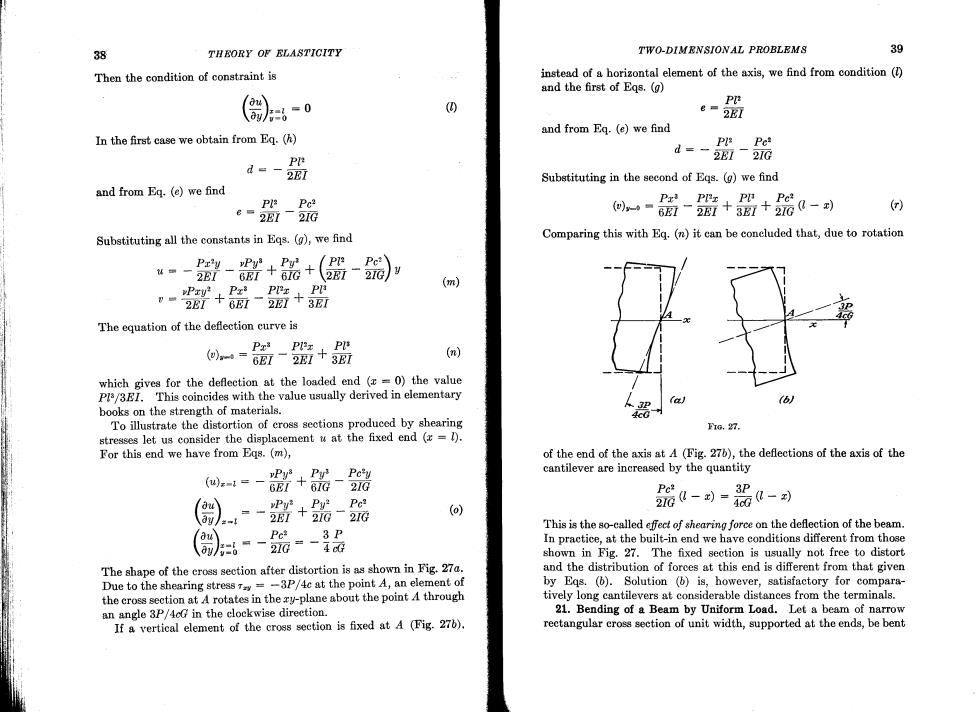
38 THEORY OF ELASTICITY TWO-DIMENSIONAL PROBLEMS 39 Then the condition of constraint is instead of a horizontal element of the axis,we find from condition ( and the first of Eqs.(g) P =0 ay/-0 © e=2KI and from Eq.(e)we find In the first case we obtain from Eq.(h) Pls Pc a=- PR d=-2求-21c Substituting in the second of Eqs.(g)we find and from Eq.(e)we find Pl Pc2 6=2E7-27G -筋-盟++%0-到 Px PPz P () Substituting all the constants in Eqs.(g),we find Comparing this with Eg.(n)it can be coneluded that,due to rotation -留-蒿+品+(器 /PP 置+筋路+ P (m) The equation of the deflection curve is -品-器+霜 PU (m) which gives for the deflection at the loaded end (x =0)the value Pl/3EI.This coincides with the value usually derived in elementary b books on the strength of materials. To illustrate the distortion of cross sections produced by shearing 1a.27. stresses let us consider the displacement u at the fixed end (x =D). For this end we have from Eqs.(m), of the end of the axis at A (Fig.276),the deflections of the axis of the vPys Pu Pcy cantilever are increased by the quantity (u)z-1=- 6E7+67元-210 -%+品-品8 --裙0- av/ (o) This is the so-called effect of shearing force on the deflection of the beam. Pc* 3P In practice,at the built-in end we have conditions different from those shown in Fig.27.The fixed section is usually not free to distort The shape of the cross section after distortion is as shown in Fig.27a. and the distribution of forces at this end is different from that given Due to the shearing stress Ty=-3P/4c at the point A,an element of by Eqs.(b).Solution (b)is,however,satisfactory for compara- the cross section at A rotates in the zy-plane about the point A through tively long cantilevers at considerable distances from the terminals. an angle 3P/40G in the clockwise direction. 21.Bending of a Beam by Uniform Load.Let a beam of narrow If a vertical element of the cross section is fixed at A (Fig.276). rectangular cross section of unit width,supported at the ends,be bent
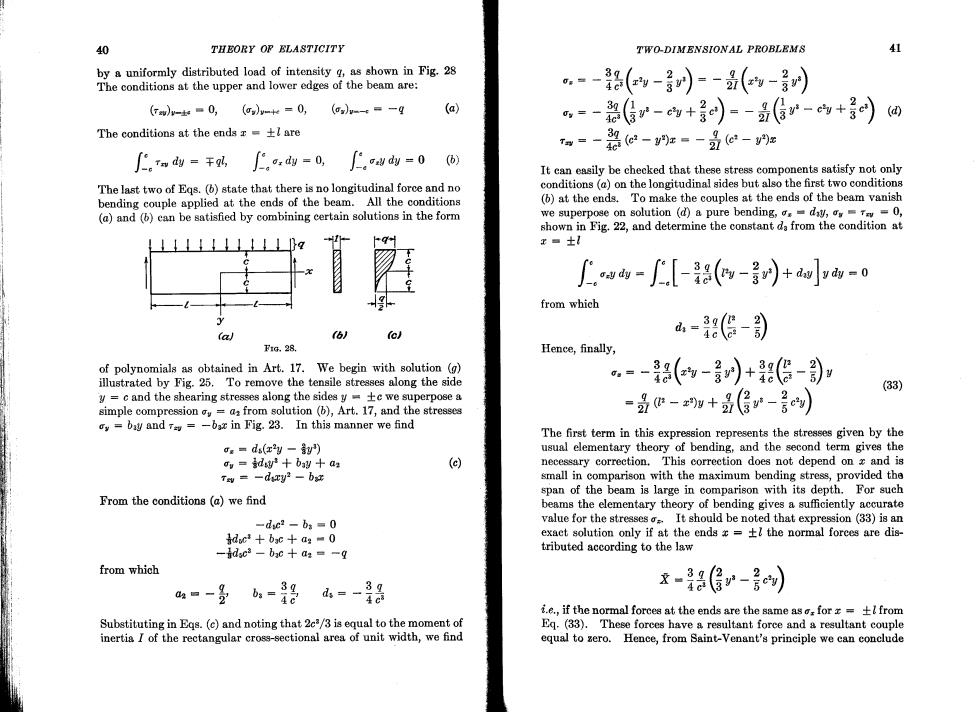
40 THEORY OF ELASTICITY TWO-DIMENSIONAL PROBLEMS 41 by a uniformly distributed load of intensity g,as shown in Fig.28 The conditions at the upper and lower edges of the beam are: 0=- (-=-(-号 (rw)-女=0,(a,)-+=0,(a)-=-q (a) =- 器(r-+=--+ 2 (d) The conditions at the ends x=l are T到=一 ∫rm山=干以∫上.,y=0, ∫wd=0 (6) It can easily be checked that these stress components satisfy not only The last two of Eqs.(6)state that there is no longitudinal force and no conditions (@)on the longitudinal sides but also the first two conditions bending couple applied at the ends of the beam.All the conditions (b)at the ends.To make the couples at the ends of the beam vanish (a)and (6)ean be satisfied by combining certain solutions in the form we superpose on solution (d)a pure bending,.=dav,=0, shown in Fig.22,and determine the constant da from the condition at x■土 Cw山-∫[-(-号)+aw]y山-0 from which (a) 61 (c) a-作-) FtG.28. Hence,finally, of polynomials as obtained in Art.17.We begin with solution (g) illustrated by Fig.25.To remove the tensile stresses along the side (33) y=c and the shearing stresses along the sides ytc we superpose a simple compression =a from solution (b),Art.17,and the stresses =员-+-号 bay and ra=-bax in Fig.23.In this manner we find The first term in this expression represents the stresses given by the og=ds(x2y-y) usual elementary theory of bending,and the second term gives the av idwyi+bay +az (c) necessary correction.This correction does not depend on x and is Tsv =-duzy2-bs small in comparison with the maximum bending stress,provided the span of the beam is large in comparison with its depth.For such From the conditions (a)we find beams the elementary theory of bending gives a sufficiently accurate -due2-bs =0 value for the stresses It should be noted that expression(33)is an tdoc*+bac +as0 exaet solution only if at the ends x =t the normal forces are dis- -idsc3-bac a:=-9 tributed according to the law from which 392 b=是a=-8 i.e.,if the normal forces at the ends are the same as o for x =lfrom Substituting in Eqs.(c)and noting that 2c2/3 is equal to the moment of Eq.(33).These forees have a resultant force and a resultant couple inertia I of the rectangular cross-sectional area of unit width,we find equal to zero.Hence,from Saint-Venant's principle we can conclude
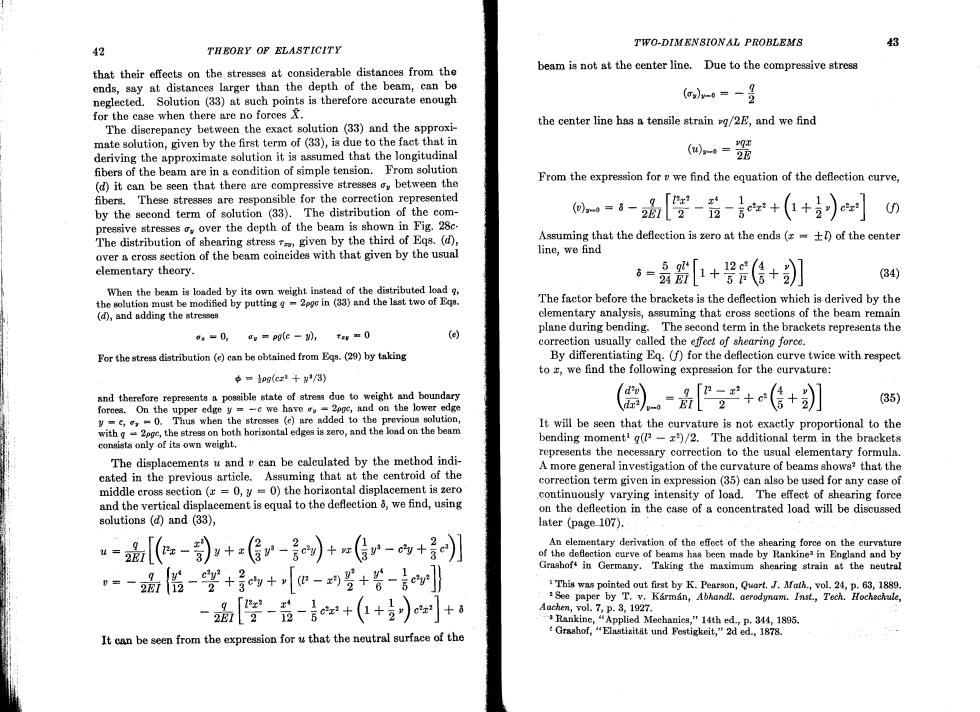
TWO-DIMENSIONAL PROBLEMS 43 42 THEORY OF ELASTICITY that their effects on the stresses at considerable distances from the beam is not at the center line.Due to the compressive stress ends,say at distances larger than the depth of the beam,can be neglected.Solution (33)at such points is therefore accurate enough ol-=-是 for the case when there are no forces X. The discrepancy between the exact solution (33)and the approxi- the center line has a tensile strain pg/2E,and we find mate solution,given by the first term of(33),is due to the fact that in deriving the approximate solution it is assumed that the longitudinal -器 fibers of the beam are in a condition of simple tension.From solution (d)it can be seen that there are compressive stresses between the From the expression for v we find the equation of the deflection curve, fibers.These stresses are responsible for the correction represented by the second term of solution (33).The distribution of the com- (@)0=i- [图-后-+(+号)树]0 pressive stresses oy over the depth of the beam is shown in Fig.28c. The distribution of shearing stress given by the third of Eqs.(d), Assuming that the deflection is zero at the ends (of the center over a cross section of the beam coineides with that given by the usual line,we find elementary theory. 6=克0, 凯+号(+訓 (34) When the beam is loaded by its own weight instead of the distributed load g, the solution must be modified by putting g-2pge in (33)and the last two of Eqs. The factor before the brackets is the deflection which is derived by the (d),and adding the stresses clementary analysis,assuming that cross sections of the beam remain plane during bending.The second term in the brackets represents the 0e=0, y=pgc一,w=0 (e) correction usually called the effect of shearing force. For the stress distribution (e)can be obtained from Eqs.(29)by taking By differentiating Eq.(for the deflection curve twice with respect 中-g(cr+/3) to r,we find the following expression for the curvature: and therefore represente a possible state of stress due to weight and boundary forees.On the upper edge y=-c we have o-2pge,and on the lower edge (周[。+e(+ (35) y-c,0.Thus when the stresses (e)are added to the previous solution, with g -2pge,the stress on both horisontal edges is zero,and the load on the beam It will be seen that the curvature is not exactly proportional to the consists only of its own weight. bending moment!g(12-x)/2.The additional term in the brackets represents the necessary correction to the usual elementary formula. The displacements u and y can be calculated by the method indi- A more general investigation of the curvature of beams shows?that the cated in the previous article.Assuming that at the centroid of the correction term given in expression (35)can also be used for any case of middle cross section (r =0,y=0)the horizontal displacement is zero continuously varying intensity of load.The effect of shearing force and the vertical displacement is equal to the defleetion 8,we find,using on the deflection in the case of a concentrated load will be discussed solutions (d)and (33), later (page 107). u-[(-+(r-e)+(Gr-+e An elementary derivation of the effect of the shearing force on the curvature of the deflection curve of beams has been made by Rankine in England and by Grashofs in Germany.Taking the maximum shearing strain at the neutral =一 品临-+的 +[-+若-言w]} This was pointed out first by K.Pearson,Quert.J.Math.,vol.24,p.63,1889. -[竖--+(+四]+ See paper by T.v.Karman,Abhandl.aerodynam.Inst.,Tech.Hochechule, Aachen,vol.7,p.3,1927. Rankine,"Applied Mechanics,"14th ed.,p.344,1895. It can be seen from the expression for u that the neutral surface of the t Grashof,"Elastizitiit und Festigkeit,"2d ed.,1878